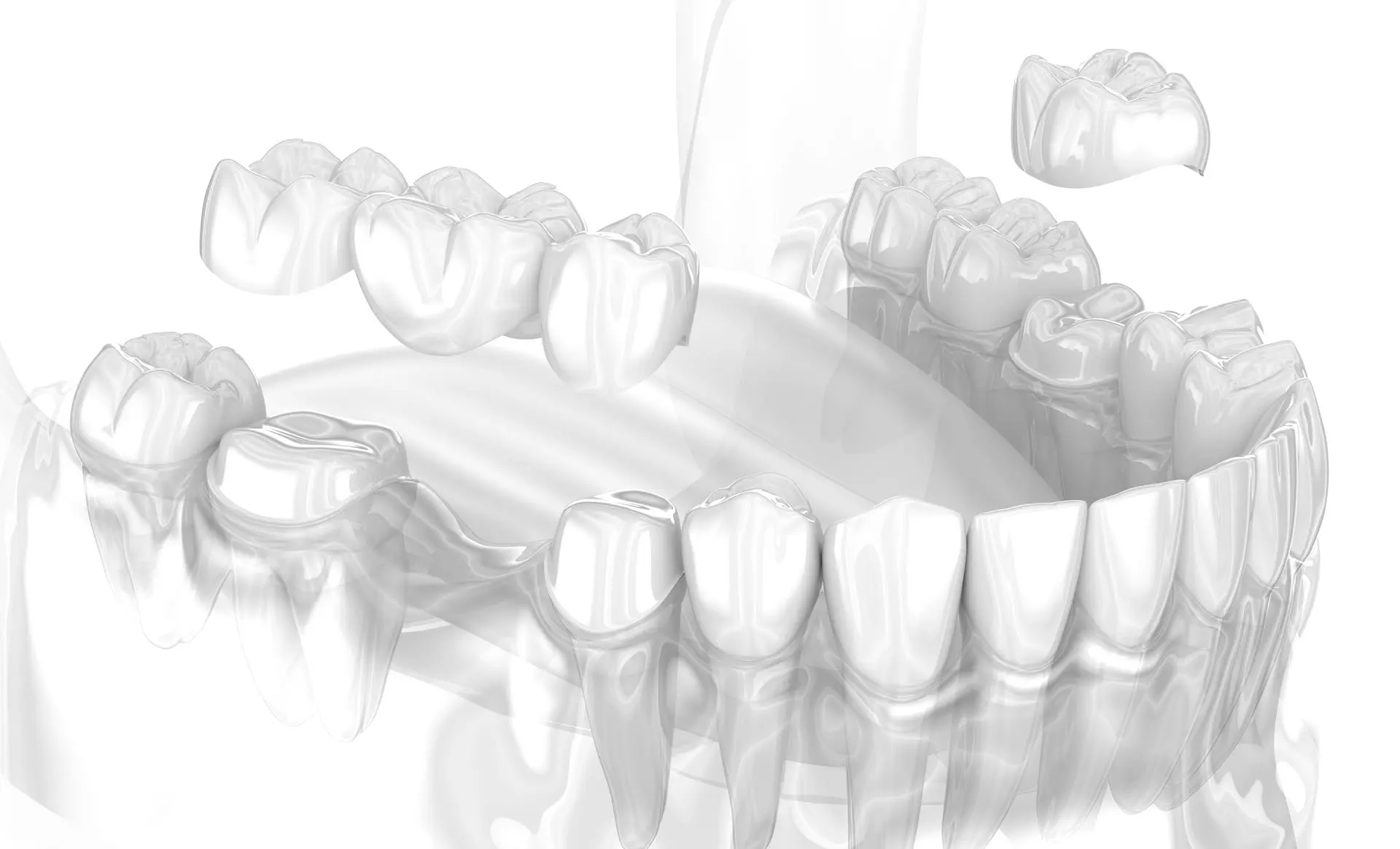Zahnbrücke: Perfekte Lösung für fehlende Zähne
Zahnbrücken sind ideal um fehlende Zähne zu ersetzen. Erfahren Sie mehr über die verschiedenen Arten von Zahnbrücken, ihre Vorteile und wie Sie Ihre Zahngesundheit verbessern können.

Warum Zahnbrücken die ideale Wahl bei Zahnlücken sind
Zahnbrücken sind eine bewährte Methode, um Zahnlücken zu schließen und die Funktionalität sowie Ästhetik des Gebisses wiederherzustellen. In der Zahnklinik Wien Döbling bieten wir maßgeschneiderte Lösungen für Zahnbrücken, die Ihren individuellen Bedürfnissen entsprechen.
Was sind Zahnbrücken?
Zahnbrücken sind festsitzende Lösungen als Zahnersatz, um einen oder mehrere fehlende Zähne zu ersetzen. Sie bestehen aus mehreren verbundenen Kronen, die auf den benachbarten Zähnen oder Implantaten befestigt werden.
Bedeutung und Vorteile von Zahnbrücken
Zahnbrücken helfen, die Kaueffizienz und Sprachfunktion zu verbessern, die Ästhetik des Lächelns zu erhalten und das Verschieben der benachbarten Zähne zu verhindern. Sie bieten eine langlebige und stabile Lösung für Zahnlücken und tragen zur allgemeinen Mundgesundheit bei.

Arten von Zahnbrücken
Zu den gängigen Arten zählen Brücken, die an benachbarten Zähnen befestigt werden und Freiendbrücken, die nur auf einer Seite abgestützt sind. Besonders vorteilhaft sind implantatgetragene Keramikbrücken, die auf künstlichen Zahnwurzeln verankert werden und eine langfristige, stabile Lösung bieten, ohne die benachbarten Zähne zu belasten. Sie überzeugen durch ihre natürliche Ästhetik und hohe Biokompatibilität, was sie zu einer idealen Wahl für Patienten macht, die eine robuste und ästhetische Lösung suchen.
01.
Implantatgetragene Brücken
Implantatgetragene Brücken werden fest auf Zahnimplantaten verankert, die im Kieferknochen befestigt sind und eine äußerst stabile und langlebige Lösung bieten, die den natürlichen Zähnen sehr nahekommt. Einer der größten Vorteile dieser Methode ist die Schonung der Nachbarzähne, da diese nicht als Stützpfeiler dienen müssen. Zudem schützen implantatgetragene Brücken den Kieferknochen vor Knochenabbau, da die Implantate den Knochen ähnlich wie natürliche Zahnwurzeln stimulieren. Durch ihre feste Verankerung bieten implantatgetragene Brücken eine hohe Stabilität und Funktionalität, vergleichbar mit natürlichen Zähnen. Zusätzlich zeichnen sie sich durch ihre ästhetische Anpassungsfähigkeit aus, da sie in Farbe, Form und Funktion den natürlichen Zähnen nachempfunden werden und ein harmonisches Lächeln ermöglichen. Dank ihrer Langlebigkeit und Widerstandsfähigkeit gegen alltägliche Belastungen können implantatgetragene Brücken bei richtiger Pflege viele Jahre, oft sogar Jahrzehnte, halten.
02.
Freiendbrücken
Freiendbrücken sind nur auf einer Seite verankert und “hängen” frei über die Zahnlücke. Im Vergleich zu implantatgetragenen Brücken haben sie mehrere Nachteile. Die Stabilität ist geringer, da die Belastung auf den einzelnen Stützpfeiler deutlich höher ist. Zudem fehlt die notwendige Stimulation des Kieferknochens, was zu Knochenabbau führen kann. Aufgrund dieser Eigenschaften sind Freiendbrücken in der Regel weniger robust und langlebig als implantatgetragene Brücken und eignen sich
03.
Traditionelle Zahnbrücken
Traditionelle Zahnbrücken werden auf natürlichen Zähnen befestigt, die als Stützpfeiler dienen. Diese Zähne müssen in der Regel beschliffen werden, um Platz für die Brücke zu schaffen.
Jetzt Beratungstermin online buchen →Materialien für Zahnbrücken
Geeignete Materialien
Zahnbrücken können aus verschiedenen Materialien gefertigt werden, die jeweils spezifische Eigenschaften und Vorteile mit sich bringen. Zu den am häufigsten verwendeten Materialien gehören Vollkeramik, Metallkeramik und Metalllegierungen. Die Wahl des geeigneten Materials hängt von mehreren Faktoren ab, darunter die ästhetischen Wünsche des Patienten, die Position der Brücke im Mund und individuelle gesundheitliche Voraussetzungen. Vollkeramische Zahnbrücken bieten eine hervorragende ästhetische Lösung mit hoher Biokompatibilität. Metallkeramische Brücken vereinen Stabilität und ansprechendes Aussehen. Metalllegierungen sind besonders langlebig und biokompatibel, jedoch weniger für sichtbare Bereiche geeignet.
Vollkeramik
Vollkeramische Zahnbrücken bestehen aus Keramik und bieten herausragende ästhetische und funktionale Eigenschaften. Zu den ästhetischen Vorteilen gehört die natürliche Optik: Vollkeramik imitiert die natürlichen Zähne sehr gut, sowohl in Farbe als auch in Lichtdurchlässigkeit, was sie besonders für den Frontzahnbereich ideal macht. Zudem kann Keramik perfekt an die Farbe der umliegenden Zähne angepasst werden, was eine harmonische und unsichtbare Einfügung in das Zahnbild ermöglicht.
In Bezug auf die Biokompatibilität sind Vollkeramik-Zahnbrücken besonders vorteilhaft, da sie keine Allergien auslösen, da sie keine Metallteile enthalten. Dies ist besonders vorteilhaft für Patienten mit Metallunverträglichkeiten. Außerdem ist Keramik sehr schonend zum Zahnfleisch und reduziert das Risiko von Reizungen oder Entzündungen im Vergleich zu metallhaltigen Zahnersatzmaterialien.
Funktional bieten vollkeramische Zahnbrücken hohe Stabilität: ähnliche Eigenschaften wie Zahnhartsubstanz, moderne Hochleistungskeramiken sind sehr robust und widerstandsfähig gegenüber Kaudruck, was sie zu einer langlebigen Lösung macht. Zudem sind sie weniger anfällig für Kariesbildung, da Vollkeramik eine glatte, nicht poröse Oberfläche bietet, auf der sich Bakterien nur schwer festsetzen können.
Einzelimplantat vs. Zahnbrücke
Die Wahl zwischen einem Einzelimplantat und einer Zahnbrücke hängt von verschiedenen Faktoren ab, einschließlich der Zahngesundheit, der finanziellen Situation und den individuellen Bedürfnissen des Patienten. Ein ausführliches Beratungsgespräch mit Ihrem Zahnarzt kann Ihnen helfen, die beste Entscheidung für Ihre spezifische Situation zu treffen.
Wann ist ein Einzelimplantat die bessere Wahl?
Ein Einzelimplantat ist besonders geeignet, wenn nur ein Zahn ersetzt werden muss (Schaltlücke) und die benachbarten Zähne gesund sind. In solchen Fällen ermöglicht das Einzelimplantat, den fehlenden Zahn zu ersetzen, ohne die benachbarten Zähne zu beeinträchtigen. Dies ist besonders wichtig, um die natürliche Zahnstruktur zu erhalten und langfristige Zahngesundheit zu gewährleisten. Implantate werden nur dann wenn gesetzt, wenn genug Knochen vorhanden ist, ansonsten ist eine Brücke empfehlenswert.
Vor- und Nachteile von Einzelimplantaten und Zahnbrücken
Hier vergleichen wir die Vor- und Nachteile von Einzelimplantaten und Zahnbrücken. Sie erfahren, wann ein Einzelimplantat die bessere Wahl ist und welche Vorteile es bietet, sowie die Vorteile und Nachteile von Zahnbrücken. Dieser Vergleich hilft Ihnen, die beste Lösung für Ihren Zahnersatz zu finden und informiert Sie über die verschiedenen Aspekte beider Optionen.
Ein Einzelimplantat ist eine besonders geeignete Wahl, wenn nur ein Zahn ersetzt werden muss und die benachbarten Zähne gesund sind. Es bietet den Vorteil, dass es die benachbarten Zähne schont, da diese nicht beschliffen oder verändert werden müssen. Zudem verhindert das Implantat den Knochenabbau im Kiefer, da es den Knochen stimuliert und somit dessen Struktur erhält. Diese hohe Stabilität und Langlebigkeit machen Einzelimplantate zu einer dauerhaften Lösung. Oft ist das Einzelimplantat günstiger, jedoch ist die Behandlungsdauer länger, da der Kieferknochen Zeit benötigt, um mit dem Implantat zu verwachsen.
Zahnbrücken hingegen bieten eine schnellere Lösung im Vergleich zu Einzelimplantaten. Sie können innerhalb von 24 Stunden eingesetzt werden, was die Behandlung effizienter macht. Allerdings müssen bei dieser Methode die benachbarten Zähne beschliffen werden, was deren Struktur schwächt und das Risiko für Karies und andere Probleme erhöht. Eine Brücke ist darüber hinaus schwieriger zu reinigen. Zudem fördert eine Zahnbrücke nicht den Erhalt des Kieferknochens, was langfristig zum Knochenabbau im Bereich des fehlenden Zahnes führen kann.

Unser eigenes Zahnlabor
Unser hauseigenes Zahnlabor ermöglicht es uns, Zahnbrücken schnell und präzise herzustellen. Die enge Zusammenarbeit zwischen Zahnärztinnen, Zahnärzten und Zahntechnikerinnen und Zahntechnikern sorgt für eine optimale Passform und Qualität. Durch den Einsatz modernster Technologien wie Intraoralscanner und CAD/CAM-Systeme können wir sicherstellen, dass jede Brücke perfekt passt und höchsten ästhetischen Ansprüchen genügt. Dank unserer effizienten Arbeitsweise können wir maßgeschneiderte Lösungen für Ihren Zahnersatz oft innerhalb von 24 Stunden anfertigen und einsetzen.

Der Behandlungsablauf
Im folgenden Abschnitt erfahren Sie alles Wichtige zum Behandlungsablauf bei Zahnbrücken. Wir erläutern die einzelnen Schritte von der Erstberatung über die Abdrucknahme bis hin zur Anfertigung und Einsetzung der Zahnbrücke in unserem hauseigenen Labor. Diese präzisen und sorgfältig abgestimmten Abläufe sorgen dafür, dass Ihre Zahnbrücke perfekt passt und Ihnen langfristig ein gesundes Lächeln schenkt.
Erstberatung und Untersuchung
Der Behandlungsprozess für Zahnbrücken beginnt mit einer umfassenden Erstberatung und Untersuchung. Dabei wird das gesamte Gebiss, die Zahnstruktur gründlich untersucht, um den Zustand der Zähne und des Kieferknochens zu bewerten. Röntgenaufnahmen werden angefertigt, um eine präzise Diagnose zu stellen und die beste Behandlungsoption zu bestimmen.
Abdrucknahme und Vorbereitung – mittels Intraoralscanner
Je nach Variante werden bei Bedarf zwei Zähne als Stützpfeiler beschliffen. Anstelle der herkömmlichen Abformmethoden - die allgemein bekannte Abdrucknahme - nutzen wir in der Zahnklinik Wien Döbling moderne Intraoralscanner. Diese Geräte erstellen hochpräzise 3D-Bilder der Zähne und des Mundraums, was eine exakte Planung und Herstellung der Zahnbrücke ermöglicht. Diese Methode ist nicht nur komfortabler für den Patienten und minimiert den Würgereiz, sondern ist auch präziser und schneller.
Nach dem Beschliff erhält der Patient ein Zahnbrücken-Provisorium auf die beschliffenen Zähne. Oft sogar schon eine ganze Provisorium-Brücke. Sie wird bis zur endgültigen Herstellung der Vollkeramikbrücke getragen und schützt die vorbereiteten Zähne und stellt die Funktionalität sowie die Ästhetik sicher.
Herstellung der Zahnbrücke im Zahnlabor
Die gewonnenen digitalen Abdrücke werden an unser hauseigenes zahntechnisches Labor weitergeleitet. Hier werden Zahnbrücken mit Hilfe von CAD/CAM-Technologie (Computer-Aided Design und Computer-Aided Manufacturing) gefertigt. Diese Technologie ermöglicht eine hochpräzise und individuelle Anpassung der Brücken. Die enge Zusammenarbeit zwischen Zahnärztinnen, Zahnärzten und Zahntechnikern gewährleistet eine perfekte Passform und optimale Funktionalität.
Einsetzen und Anpassung der Brücke
Sobald die Zahnbrücke im Labor fertiggestellt ist, wird sie in einer weiteren Sitzung eingesetzt. Zunächst werden die Passform und der Biss überprüft, und bei Bedarf werden Anpassungen vorgenommen. Nach der Feinjustierung wird die Brücke mit einem speziellen dentalen Zement dauerhaft fixiert. Dieser Schritt stellt sicher, dass die Brücke fest sitzt und sofort ihre volle Funktionalität entfaltet.
Pflege und Nachsorge
Die richtige Pflege und Nachsorge sind entscheidend, um die Langlebigkeit Ihrer Zahnbrücken zu gewährleisten. Regelmäßiges Zähneputzen mit einer weichen Zahnbürste und die Verwendung von Zahnseide oder speziellen Interdentalbürsten helfen, Plaque und Essensreste zu entfernen. Eine gründliche Mundhygiene ist wichtig, um das Zahnfleisch gesund zu halten und Karies zu vermeiden. Regelmäßige Kontrolluntersuchungen beim Zahnarzt sind unerlässlich, um den Zustand der Brücke zu überwachen und mögliche Probleme frühzeitig zu erkennen. Professionelle Zahnreinigungen tragen zur Erhaltung der Brücke bei und verhindern Komplikationen wie Entzündungen. Mit unserem strukturierten und präzisen Behandlungsablauf stellen wir sicher, dass Sie eine Zahnbrücke erhalten, die nicht nur ästhetisch ansprechend, sondern auch funktional und langlebig ist.
Autor
Dr. Matthias Göstel
Zahnarzt, ärztlicher Leiter
Zahnklinik Wien Döbling
27.8.2024
Wir sind für Sie da!

Telefon
Sie können uns gerne Mo-Fr 8-18 Uhr anrufen und sich telefonisch einen Termin vereinbaren.
01 320 97 97 →
Online Buchung
Sie können sich auch gerne bequem online und rund um die Uhr einen Termin vereinbaren.
Online Terminbuchung →
Schreiben Sie uns einfach und unkompliziert eine formlose E-Mail. Wir freuen uns über Ihre Nachricht!
office@zwd.at →Häufig gestellte Fragen (FAQs) zur Zahnbrücke
Hier finden Sie alle häufig gestellten Fragen. Wenn Sie weitere Fragen haben, können Sie sich jederzeit gerne an uns wenden und einen Beratungstermin vereinbaren. Wir sind Mo-Fr 8-18 Uhr unter 01 320 97 97 erreichbar. Gerne können Sie auch unsere Online Terminbuchung nutzen. Wir freuen uns auf Ihren Besuch!
Eine Zahnbrücke ist eine prothetische Versorgung, die verwendet wird, um eine oder mehrere fehlende Zähne zu ersetzen. Sie besteht aus künstlichen Zähnen (Pontics), die durch Kronen an den benachbarten natürlichen Zähnen oder Implantaten befestigt sind und die Lücke optisch schließen. Eine spezielle Form davon ist die Keramikbrücke, die vollständig aus Keramik besteht und eine besonders ästhetische Lösung bietet.
Eine Zahnbrücke funktioniert, indem sie die Lücke eines oder mehrerer fehlender Zähne schließt. Die Brücke wird an den benachbarten Zähnen oder Implantaten befestigt und bildet so eine stabile Struktur, die das Kauen und Sprechen erleichtert. Bei einer Keramikbrücke wird diese Stabilität kombiniert mit einer natürlichen Ästhetik.
Es gibt verschiedene Arten von Zahnbrücken, darunter:
Implantatgetragene Brücken:
Diese werden auf Zahnimplantaten befestigt und bieten eine dauerhafte Lösung.
Traditionelle Zahnbrücken:
Diese werden an den benachbarten natürlichen Zähnen befestigt, die als Anker dienen.
Keramikbrücken:
Diese bestehen komplett aus Keramik und bieten eine hervorragende ästhetische Qualität.
Freiendbrücken:
Diese werden verwendet, wenn nur ein benachbarter Zahn zur Befestigung vorhanden ist.
Implantatgetragene Brücken bieten mehrere Vorteile:
Langlebigkeit:
Sie sind stabil und langlebig.
Schutz der natürlichen Zähne:
Sie erfordern keine Beschädigung der benachbarten Zähne.
Knochenstimulation:
Implantate helfen, den Kieferknochen zu erhalten.
Traditionelle Zahnbrücken haben einige Nachteile:
Beschliff der benachbarten Zähne:
Die benachbarten Zähne müssen beschliffen werden.
Geringere Haltbarkeit:
Sie sind möglicherweise weniger langlebig als implantatgetragene Brücken.
Knochenverlust:
Sie bieten keine Stimulation für den Kieferknochen.
Freiendbrücken werden verwendet, wenn nur ein benachbarter Zahn vorhanden ist. Nachteile umfassen:
Geringere Stabilität:
Sie sind weniger stabil als implantatgetragene Brücken.
Begrenzte Anwendung:
Sie sind nicht für alle Zahnlücken geeignet.
Zahnbrücken können aus verschiedenen Materialien hergestellt werden, einschließlich:
Metall:
Robust und langlebig, aber weniger ästhetisch.
Keramik:
Ästhetisch ansprechend und natürlich aussehend.
Vollkeramik:
Bietet die beste Ästhetik und ist biokompatibel. Keramikbrücken sind eine häufig gewählte Option für diejenigen, die eine besonders natürliche Optik wünschen.
Vollkeramikbrücken, einschließlich Keramikbrücken, bieten:
Natürliche Ästhetik:
Sie sehen wie natürliche Zähne aus.
Biokompatibilität:
Sie sind gut verträglich für das Zahnfleisch und umliegendes Gewebe.
Keine Verfärbungen:
Keramik verfärbt sich nicht wie andere Materialien.
Der Behandlungsablauf für eine Zahnbrücke umfasst mehrere Schritte:
Erstberatung und Untersuchung:
Der Zahnarzt erstellt einen Behandlungsplan.
Abdrucknahme und Vorbereitung:
Zuerst erfolgt die Präparation/Beschliff dann werden mit einem Intraoralscanner präzise Abdrücke genommen.
Herstellung im Zahnlabor:
Die Brücke, wie z. B. eine Keramikbrücke, wird individuell im Zahnlabor gefertigt.
Einsetzen und Anpassung: Die fertige Brücke wird eingesetzt und angepasst.
Die Kosten für eine Zahnbrücke, einschließlich Keramikbrücken, können variieren und hängen von mehreren Faktoren ab, einschließlich des verwendeten Materials, der Art der Brücke und der Komplexität der Behandlung. Implantatgetragene Brücken sind in der Regel teurer als traditionelle Brücken, bieten jedoch zusätzliche Vorteile wie Langlebigkeit, Stabilität und Knochenerhalt. Unser Team berät Sie gerne und erstellt Ihnen einen individuellen Kostenplan.
Die Lebensdauer einer Zahnbrücke hängt von der Pflege und den verwendeten Materialien ab. Bei guter Mundhygiene und regelmäßigen Kontrollbesuchen kann eine Zahnbrücke, insbesondere eine Keramikbrücke, viele Jahre halten, oft Jahrzehnte oder länger.
Die richtige Pflege einer Zahnbrücke, insbesondere einer Keramikbrücke, umfasst:
Tägliche Mundhygiene:
Regelmäßiges Zähneputzen und Zahnseide verwenden.
Regelmäßige Kontrollen:
Besuche beim Zahnarzt zur Überprüfung der Brücke.
Gesunde Ernährung:
Vermeiden Sie klebrige und harte Lebensmittel, die die Brücke beschädigen könnten.
Ein Zahnbrücken-Provisorium ist eine temporäre Brücke, die während der Herstellung der endgültigen Brücke getragen wird. Sie schützt die vorbereiteten Zähne und stellt die Funktionalität und Ästhetik sicher.
Die Befestigung einer Zahnbrücke erfolgt durch spezielle Dentalzemente, die eine dauerhafte Verbindung zwischen der Brücke und den natürlichen Zähnen oder Implantaten schaffen.
Zu den häufigsten Problemen mit Zahnbrücken gehören:
Lösen oder Herausfallen:
Dies kann durch Karies oder eine unzureichende Befestigung verursacht werden.
Zahnfleischentzündungen:
Schlechte Mundhygiene kann zu Entzündungen führen.
Bruch oder Risse:
Unfälle oder das Kauen auf harten Gegenständen können die Brücke beschädigen.
Mit einer Zahnbrücke können alle Lebensmittel, wie mit den eigenen Zähnen, gegessen werden.
Der Hauptunterschied besteht darin, dass eine Zahnbrücke an den benachbarten Zähnen befestigt wird, während ein Einzelimplantat direkt im Kieferknochen verankert wird. Implantate bieten eine dauerhaftere Lösung, während Brücken, insbesondere Keramikbrücken, eine ästhetische und oft kostengünstigere Option darstellen.
Ein Einzelimplantat ist die bessere Wahl, wenn:
Langlebigkeit:
eine dauerhafte Lösung gewünscht wird,
Knochenangebot:
genug Knochen verfügbar ist,
Knochenerhalt:
der Kieferknochen stimuliert werden soll,
Nachbarzähne:
die benachbarten Zähne gesund sind und nicht belastet werden sollen.
Der Ablauf bei einem Einzelimplantat umfasst:
Implantation:
Einsetzen des Implantats in den Kieferknochen. Bei Bedarf kann davor ein Knochenaufbau durchgeführt werden.
Heilungsphase:
Das Implantat muss in den Knochen einwachsen.
Befestigung des Zahnersatzes:
Auf dem Implantat wird eine Krone befestigt.
Ein eigenes Zahnlabor bietet mehrere Vorteile:
Qualitätssicherung:
Direkte Kontrolle über den Herstellungsprozess.
Präzision:
Individuelle Anpassungen und präzise Anfertigung, besonders bei Keramikbrücken.
Schnelligkeit:
Schnellere Herstellung und Anpassung der Brücke.
Die Lebensdauer einer Zahnbrücke, insbesondere einer Keramikbrücke, kann durch folgende Maßnahmen verlängert werden:
Gute Mundhygiene:
Regelmäßiges Zähneputzen und Zahnseide verwenden.
Regelmäßige Zahnarztbesuche:
Kontrollen und professionelle Reinigungen.
Vermeidung von schädlichen Gewohnheiten:
Vermeiden Sie Kauen auf harten Gegenständen und knirschen Sie nicht mit den Zähnen.
Eine Brücke kann nicht repariert werden, jedoch ausgetauscht werden, da sie am Zahn fest verklebt ist. Die Implantatbrücken können repariert werden, jedoch ist eine Neuanfertigung oft sinnvoller.
Eine Zahnbrücke sollte mindestens zweimal jährlich im Rahmen einer Routinekontrolle beim Zahnarzt überprüft werden.


